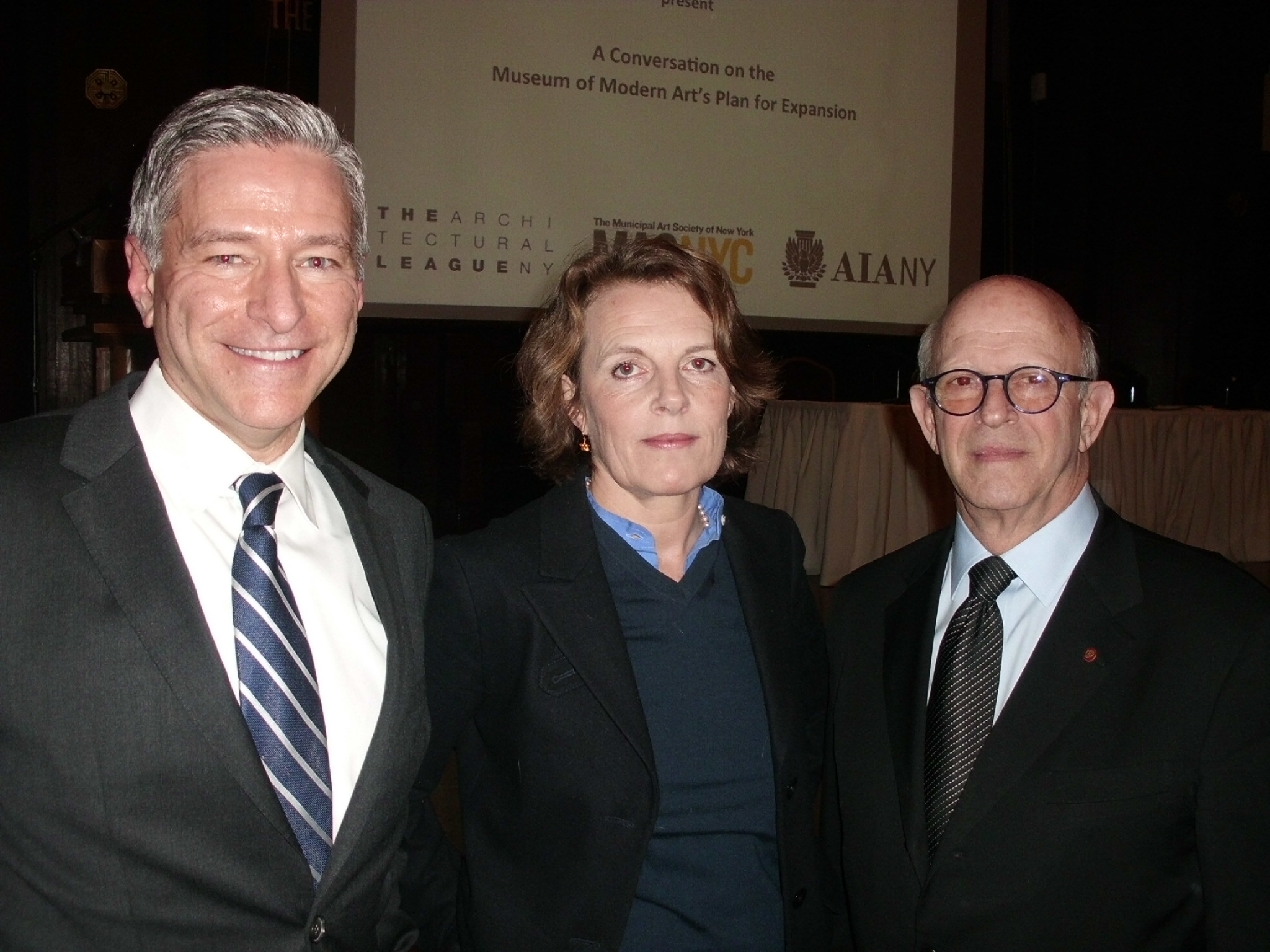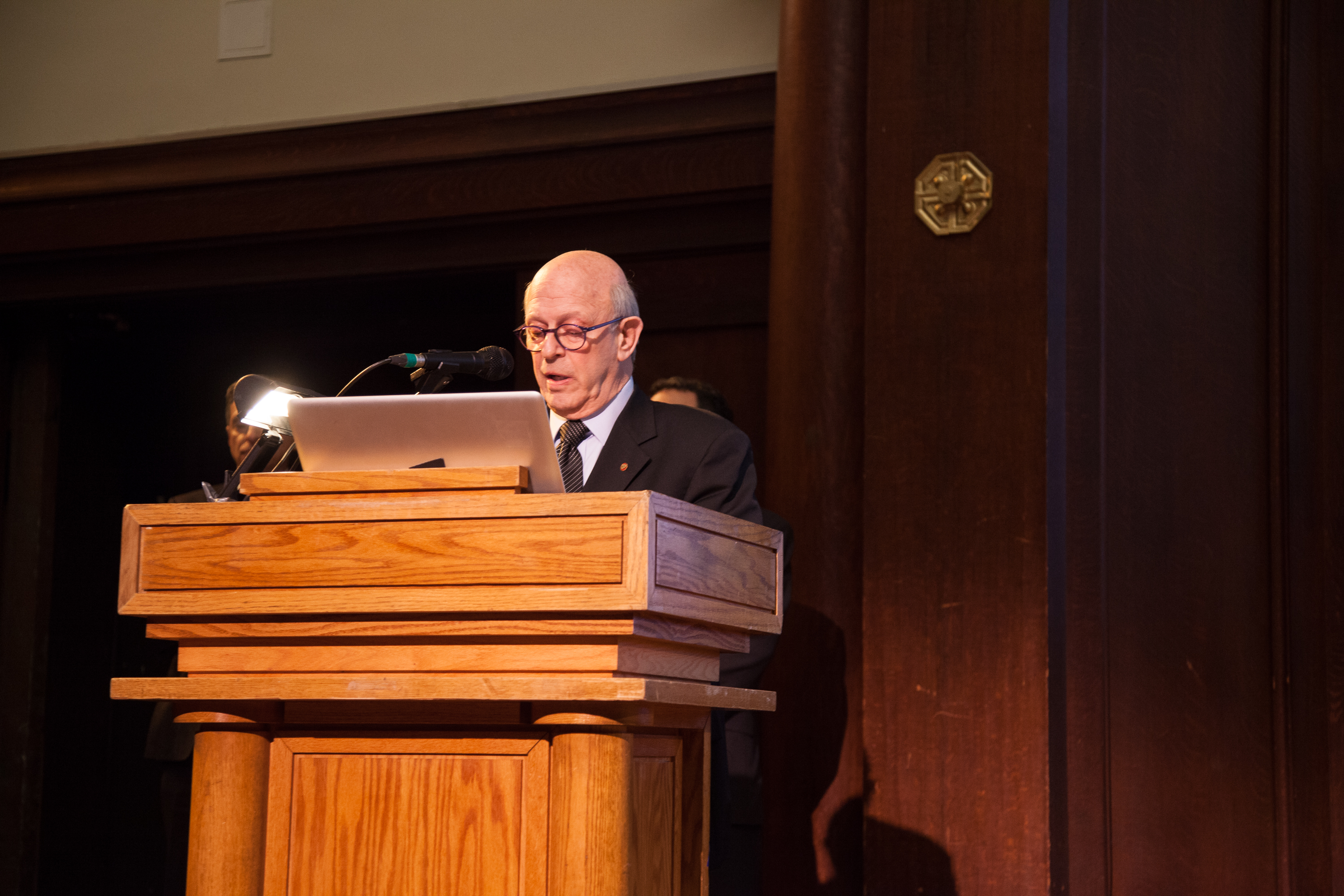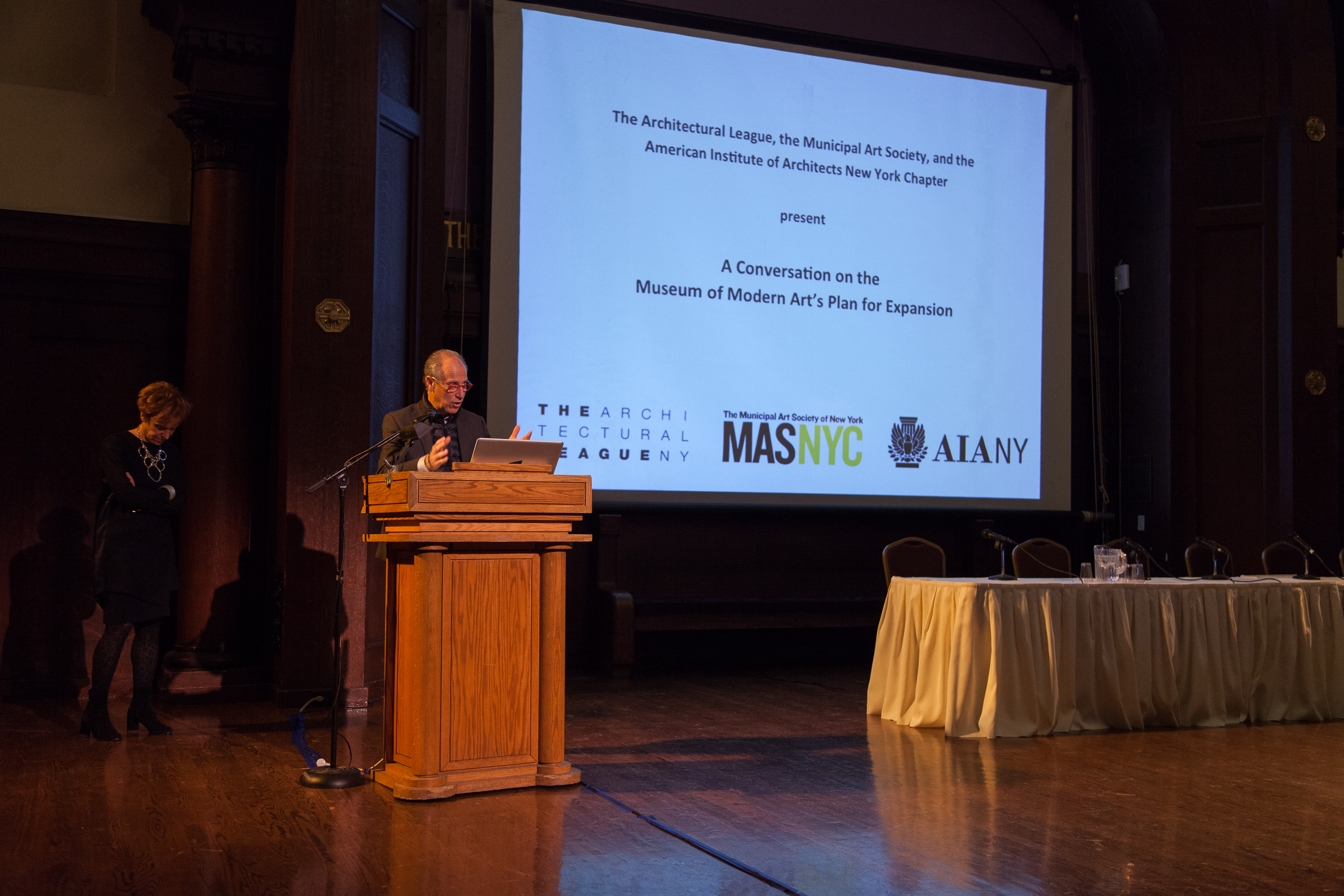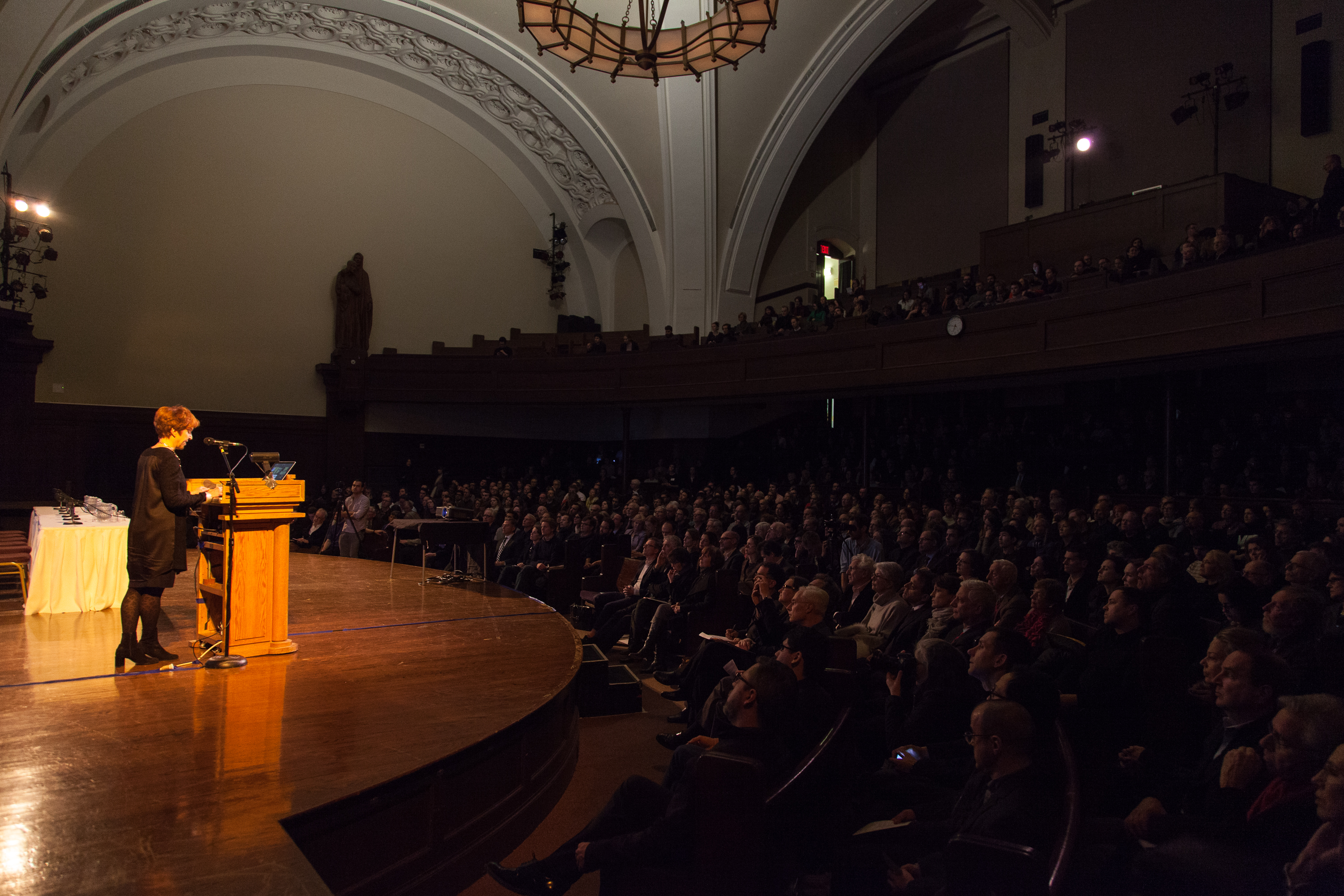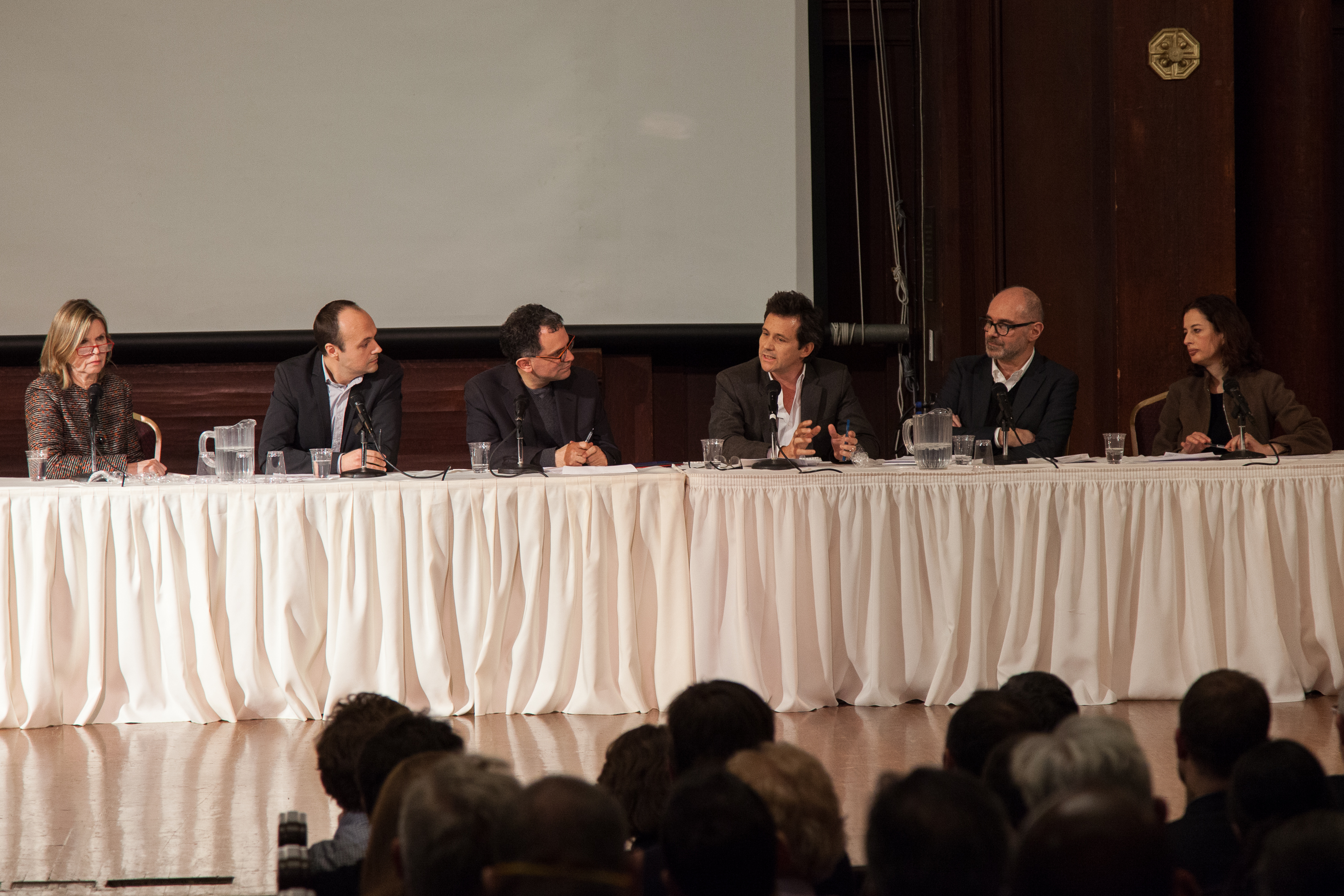by: Rick Bell FAIA Executive Director AIA New York
Last Tuesday, 01.28.14, a public conversation about the Museum of Modern Art’s expansion plan was convened by The Architectural League of New York, the Municipal Art Society, and AIA New York (to see a video of the full event, click here).
Liz Diller presented the results of the Diller Scofidio + Renfro six-month study commissioned by MoMA, and started her remarks with praise for the American Folk Art Museum, saying: “This is a building by our much-respected colleagues Tod Williams and Billie Tsien. We welcome the opportunity to speak before this group of peers to address these issues in an unfiltered way – even if we don’t change a single mind in the room.”
After welcomes from League president Annabelle Selldorf, FAIA, and MAS President Vin Cipolla, AIANY’s 2014 President Lance Jay Brown, FAIA, spoke of how “as architects and designers, we at the AIA were interested in co-sponsoring this forum because we continually grapple with issues of complex balancing: balancing preservation and change – the morphology of the city; balancing public interest and owner’s needs; and balancing the competing urban scales of the building, the street, and the city.” Before introducing event moderator Reed Kroloff, Assoc. AIA, Brown noted that “other places will learn lessons from what they see and hear today.”
Whether or not minds were changed in the Ethical Culture Society’s auditorium, where more than 650 architects, designers, preservationists, and enthusiasts came together, is partially irrelevant, though people did come up to the stage afterwards to say that they had learned a lot, and had started to question their preconceptions. AIA New York, along with our institutional colleagues, had called for a public discussion about three key issues: the specifics of the expansion plan which presumed the demolition of the AFAM building; the urban role of MoMA and its Midtown campus; and the cultural identity of museums in the city. The building-oriented presentations by MoMA Director Glenn Lowry and Diller were augmented by an interesting programmatic primer relating to MoMA’s collections and temporary exhibition strategy by Ann Temkin, The Marie-Josée and Henry Kravis Chief Curator of Painting and Sculpture. With the plan positing a 30% increase in space for both the permanent collection and temporary shows, Temkin noted: “We can show a room full of many dozens of paintings by Mark Rothko and we can do that kind of depth with each of a dozen artists. We have different kinds of depth, not just monographic collections … With all of these responsibilities for breadth, depth, and for the ever-increasing scale, we have a responsibility for MoMA to not only be a museum but also a catalyst.” Lowry declared simply that the AFAM building would be demolished, saying, “Our decision wasn’t easy and isn’t taken lightly. We ultimately concluded it simply wasn’t possible. We want to show more of our extraordinary collection in different ways, allowing us to engage our public in new ways.”
The firm of Diller Scofidio + Renfro was hired to design a comprehensive expansion for the Museum of Modern Art after MoMA had announced the demolition of the American Folk Art Museum building. DS+R had challenged MoMA’s decision and worked for six months on various programmatic scenarios for adaptive reuse of the building. Despite the lengthy and rigorous efforts to find a way of preserving the integrity of the AFAM structure while meeting MoMA’s curatorial and educational goals, the firm was not able to find a solution that was acceptable to MoMA and kept the volumetric spirit of the building. Most of the presentation by Liz Diller – some 30 of the 35 minutes allotted – were devoted to addressing the adaptive reuse studies that were not published in the articles about the new direction announced by MoMA.
The ensuing discussion, moderated by Kroloff, director of the Cranbrook Academy, included panelists Cathleen McGuigan, editor-in-chief of Architectural Record; Jorge Otero-Pailos, Associate Professor at Columbia University’s Graduate School of Architecture, Planning & Preservation; Nicolai Ouroussoff, former architecture critic at the New York Times; Stephen Rustow, AIA, a principal at Museoplan; and architectural advisor Karen Stein. Balancing ideas about preservation and curatorial needs, four of the respondents challenged some of the underlying programmatic assumptions and proposed alternatives, including a delay in rushing to demolition of the 12-year-old AFAM structure.
Stein started her comments by saying that “MoMA has a role and a responsibility to the discipline of architecture in the way that it has to art.” Otero-Palios agreed about the need to “rethink preservation,” noting, “The fine middle ground is where brilliance lies and creativity resides, and where mastery in design is expressed. MoMA, of all institutions, is the one that can see the benefit of that, pushing the envelope of what the problem is.” If anything, the rethinking of preservation credos included a questioning of the generally accepted criticism of simply retaining the façade of a significant building. In this vein, Rustow said, “Simply dismissing the approach by calling it façade-ism is to dismiss an approach to preservation.” And McGuigan was most vigorous in criticizing MoMA’s decision-making, saying: “The process is going too quickly. There was a time when we thought there would be exhibitions in the AFAM building and the Hines Building would have raw space. I think what many are thinking is that we should pause, stop, and think again.”
Ouroussoff was not convinced that the AFAM building could or should be preserved, saying, “Let’s talk about cultural priorities, including a responsibility to the city and a responsibility to the collections. We are not talking about a Mies building or a building by Louis Kahn. It is a building that is, in many ways, flawed. It is somewhat in the lineage of 2 Columbus Circle and of the New Museum. These are very tight. They have circulation problems and are difficult buildings in which to show art.” He talked about the need for a more enhanced public process, but noted that, “as critics, we set standards and we set values, and help determine how a building fits into the history of architecture. I’m not saying that this building does not have importance, does not have value, but we all have to understand when it comes to architecture, no one here is defending not making alterations to the Taniguchi building.”
After several rounds and almost an hour of interactive discussion, Kroloff opened the discussion to questions from those attending. Query cards had been distributed and many were collected by staff from the three sponsoring institutions. There was time for only six questions, but all elicited spirited and lengthy interactive reply. Among the ideas put forward during the Q&A, Heidi Blau, FAIA, asked about vertical expansion; Louise Harpman, Assoc. AIA, asked about expanding at PS1 instead; and Vishaan Chakrabarti, AIA, noted in his question that “idiosyncrasy, inefficiency, and expense were cited by the developers who wanted to demolish the High Line, but they were wrong.” Responses to all of the questions were mostly from Diller, Lowry, and Temkin, who discussed the disadvantages of bifurcating the collection or separating temporary exhibitions from the galleries housing the permanent legacy. The comparison to the High Line was challenged by Diller, who talked of the “awkwardness” of the Folk Art Museum building, and how, “if the building were less particular, it would be so much easier to make the necessary changes.“
As time ran out for the program, which ended close to 9pm, Kroloff concluded with thanks to the panelists, sponsoring institutions, and to MoMA and Diller Scofidio + Renfro, for participating in a program that put their assumptions on the line. A validation of the concept, and the evening’s civil exchange of ideas, came from the prolonged ovation given to Liz Diller for her openness and sharing.
AIANY President Brown commented that the event was of significance because it brought together members of the three sponsoring organizations. He noted that “the evening was less a motivation for a change in direction or decision than a catharsis for a community in conflict.”
The AIA New York Chapter thanks Kroloff and the panelists, our co-sponsors at the League and MAS, and those who came from MoMA and Diller Scofidio + Renfro to engage in this important public conversation about civic spirit and cultural identity.








